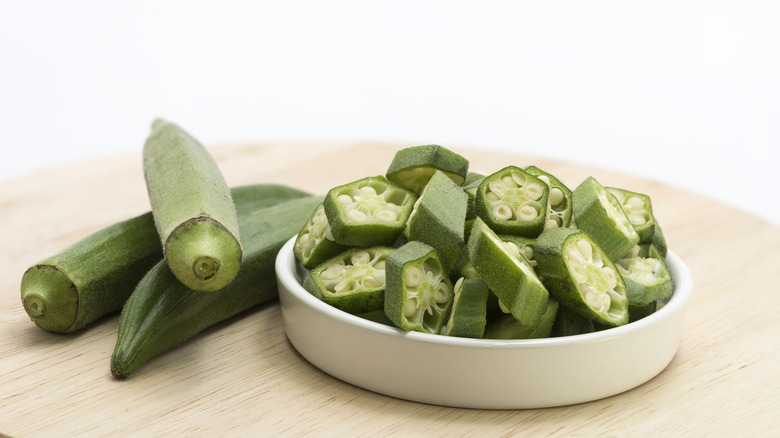The Simple Vinegar Hack You Should Follow To Fix Slimy Okra
If you're not a fan of the viscous, slimy texture that okra can sometimes take on, there's an easy hack to solve the problem. By soaking the okra in vinegar for 30 minutes, says food scientist Bryan Le, the acidity breaks up and dissolves the slime. This explains why okra pickles are generally crunchy, and remain less slimy than braised or stewed okra. Citrus juices work here too — lemon juice, for example — and even tomatoes. Okra is slimiest in neutral and basic pHs, so crank up the acid.
The next step to take to reduce sliminess is to cook the okra at a high heat, quickly. Stanford associate director and botanist Katherine Preston notes that at an internal temperature of 194 degrees Fahrenheit, the viscosity of the gel in okra thins. Fried okra is generally the favored preparation for those who can't stand okra's famous slimy texture. According to Preston's advice, high-temperature frying reduces the texture issue. Dry roasting at high temperatures or grilling hot also avoids the slime and provides a different preparation. By soaking the okra in acid, patting dry, and then roasting high, your dish will be (relatively) slime-free.
Why is okra slimy?
The sliminess of okra — called mucilage — is primarily caused by its polysaccharide content (molecules made up of many sugars bound together). The gel in the seed pods helps the plant retain moisture in the heat of the day, being endemic to tropical Africa and growing well in hot climates like India, the Middle East, and the American Southeast. As the plant matures, Katherine Preston says, the plant has different priorities. It stops producing mucus, and the plant becomes drier — but it also gets tougher and woody. Not great for eating.
Most traditional okra dishes lean into the sliminess, which serves as a natural thickening agent (and one being studied as a texture enhancer, believe it or not.) Gumbo uses okra, stewing it long and low and slow, to thicken it. Cooks in Africa add baking soda to okra soup, creating a basic pH that bumps up the mucilage factor. Makes sense, if higher pHs coax out the slime and lower pH, more acidic environments, like vinegar or citrus, help to cut it.
Preparing okra to minimize slime
When choosing okra, look for tender, hydrated, bright green pods. If you're anti-slime, you'll want to double down on the acid and high heat combination method. The other action you can take to minimize sliminess: cut the okra properly. Slice it lengthwise, using the cap of the pod to hold the strips in place as you cut down it (like how the root end of an onion helps hold it together while you chop it). Then soak the okra in acid — vinegar, lemon or lime juice, or even tomato juice — for 30 minutes or so. Drain it and pat dry.
From there, it can be prepared in several different ways: sauteed hot and fast in a pan, fried in a couple of inches of 350-degree Fahrenheit vegetable or peanut oil, roasted, or broiled. If you like creole flavors but dislike slimy okra, consider broiling it with peppers, tomatoes, celery, and a spice mix of cayenne, allspice, paprika, and red pepper flakes. If you want to try something a little more Indo-inspired, use amchoor powder (dried, powdered green mango), lime juice, and chile (cayenne or Kashmir), and serve with cucumber raita.


